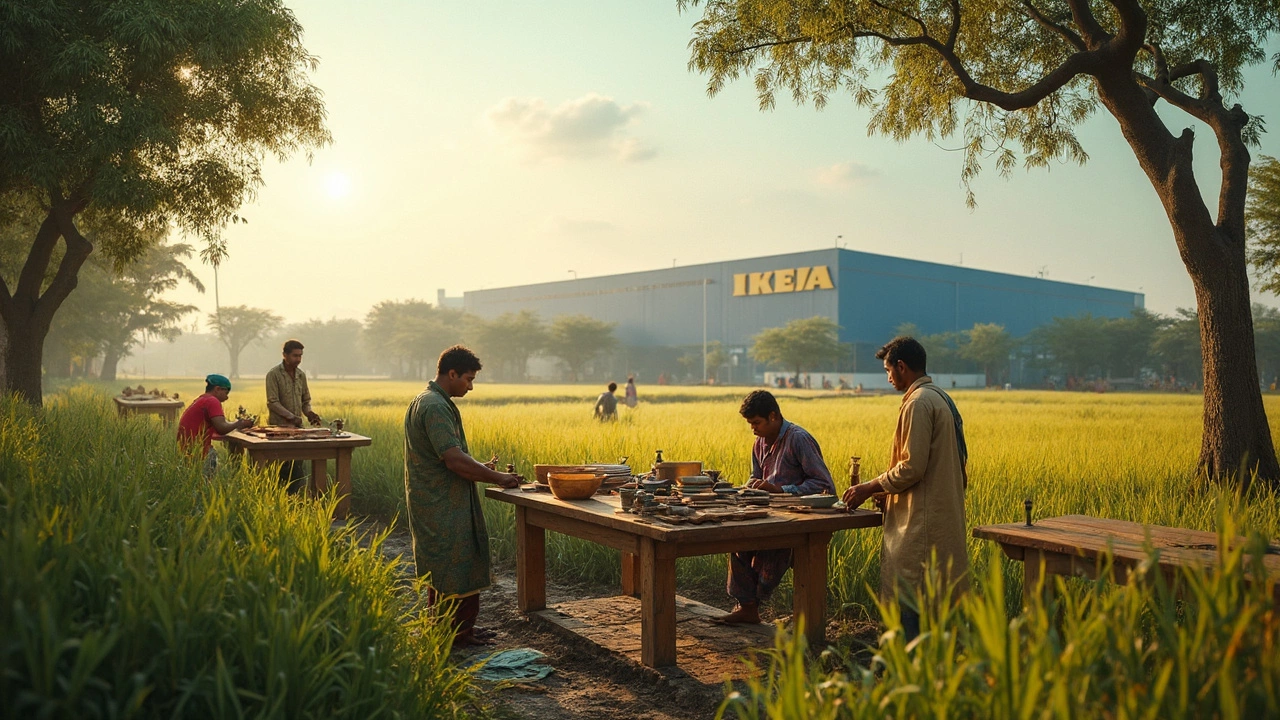India is not just on IKEA's radar—it's a massive bullseye. With a population that's rapidly inching towards 1.5 billion, that's a lot of people looking for stylish yet affordable furniture. Think about the booming middle class, eager to furnish their homes with trendy and functional designs. For IKEA, it's like finding a whole new playground filled with potential customers.
But it's not just about large numbers. The opportunity for local sourcing in India is huge. With skilled artisans and affordable raw materials readily available, it makes perfect sense for IKEA to tap into the local market. By doing so, not only does IKEA reduce costs, but it also supports local industries. It's a win-win situation!
- India's Consumer Market
- Local Sourcing Opportunities
- Economic Advantages
- Cultural Adaptation Strategies
India's Consumer Market
When it comes to India's consumer market, it’s like hitting the jackpot for a company like IKEA. Imagine this: by 2023, India's middle class was projected to reach nearly 500 million people. That’s nearly the population of the entire European Union! This massive group is all about upgrading their lifestyle, making it a fertile ground for innovative furniture solutions.
So, what makes the Indian market tick? Well, affordability and functionality are key. People want pieces that not only look good but also fit into their daily lives without burning a hole in their wallet. IKEA, known for exactly this blend, fits the bill perfectly. And let’s not forget the impact of urbanization. With more folks moving to cities, smaller apartments are becoming the norm, which means smart, space-saving furniture is in high demand.
Understanding Preferences and Trends
One thing to remember is the diverse taste palette across India. Most folks favor a mix of traditional and modern designs. They love vibrant colors and multifunctional pieces. Understanding these preferences helps IKEA refine its offerings. For example, in southern parts of India, compact and sturdy designs work because of smaller living spaces and cultural influences.
Additionally, the rise in digital literacy means more people are shopping online, providing IKEA a solid platform to showcase its wide range of offerings anytime, anywhere. This digital boom opens doors to endless possibilities for engaging with consumers in innovative ways.
Statistics and Trends
Here’s a quick look at some consumer insights:
| Year | Middle Class (in millions) | Urban Population (%) |
|---|---|---|
| 2020 | 350 | 34 |
| 2023 | 500 | 36 |
These numbers aren’t just figures; they represent millions of potential IKEA customers eager to transform their spaces. By leveraging these insights, IKEA positions itself as a go-to for home improvement solutions in India.
Local Sourcing Opportunities
So what makes local sourcing in India a goldmine for IKEA? It's all about the availability of quality materials and skilled craftsmen. India is rich in resources like wood, fabric, and metal, which are essential for making those sleek IKEA products. And let's not forget the talented artisans who've had craftsmanship in their blood for generations. Tapping into this local expertise means IKEA can create unique pieces that appeal to Indian tastes.
A while back, IKEA's Head of Purchasing in South Asia mentioned,
"India's rich tapestry of materials and skills provides an incredible opportunity to enhance our product range while aligning with our sustainability goals."
Local Artisans and Craftsmanship
By working with Indian artisans, IKEA isn't just getting great products—it's supporting local economies. These partnerships mean more jobs, skill development, and a stronger supply chain. It's like creating a mini-ecosystem where everybody wins.
Sustainability and Cost-Effectiveness
Why ship materials from other parts of the world when they're already here? Local sourcing not only cuts shipping costs but also reduces CO2 emissions—making IKEA's operations in India more eco-friendly. This is a big part of IKEA's global goal to be climate-positive by 2030.
| Material | Source in India | Benefit |
|---|---|---|
| Wood | Karnataka, Kerala | High quality and sustainably sourced |
| Textiles | Gujarat, Tamil Nadu | Rich in variety and tradition |
| Metal | Jharkhand, Odisha | Abundant and cost-efficient |
All in all, by focusing on local sourcing, IKEA aligns its business strategy with both cost-effectiveness and sustainability, making India an irresistible part of its global supply chain.

Economic Advantages
Diving into India's economic strengths, it's clear why companies like IKEA are eager to plant their roots there. First things first: India's economy is one of the fastest-growing in the world. Yeah, that's right. With a GDP growth rate hovering around 6-7%, this market is where the action's at. More growth means more spending power, and that means people ready to splash out on new furniture.
Another reason India makes sense for IKEA? Labor costs. Production costs in India are significantly lower compared to many countries. With affordable labor and a robust skilled workforce, manufacturing locally is a financial no-brainer for IKEA. This isn't just about cutting costs—it's about offering good prices to the customers, too.
Investment Opportunities
India is also all about attracting foreign investment. The Indian government has rolled out the red carpet for international brands with policies that favors external investment, especially in the retail sector. For business expansion, these business-friendly policies remove red tape and lower barriers, paving the way for companies like IKEA to operate with ease.
Let's not forget the 'Make in India' initiative. This policy aims to encourage companies to produce locally, supporting both domestic markets and the economy. IKEA's strategy fits like a glove here, as they source much of their raw materials right within the country and contribute significantly to the local economy.
Consumer Confidence
Consumer confidence in India has seen a steady rise, with people more willing to spend on home improvements and lifestyle products. According to surveys, the Indian middle class is set to double by 2030. That's a massive group of shoppers looking for quality, stylish, and affordable options. It's no wonder India is on IKEA's must-have list for expansion.
Cultural Adaptation Strategies
Entering a vibrant and diverse country like India, IKEA has its work cut out. It's more than just shipping in Swedish designs and hoping for the best. So, what strategies does IKEA employ to win over Indian customers?
Understanding Diverse Tastes
India isn't a one-size-fits-all market. With its countless languages, traditions, and styles, catering to diverse tastes is key. IKEA knows that what's popular in Delhi might not work in Chennai or Mumbai, and adapts accordingly.
One approach is local collaborations. By working with Indian designers, IKEA can create products that resonate more deeply with regional preferences. This way, they add a local touch to the global brand, offering something unique for each area.
Product Range and Customization
In India, multifunctional furniture is a big deal, especially given the varying sizes of living spaces. IKEA offers space-saving and customizable products, allowing customers to adapt furniture to their home layout and needs. Compact yet stylish solutions cater to urbanites living in smaller apartments.
What's more, IKEA makes sure its products are suitable for specific cultural practices, like low-seating arrangements for traditional events. These considerations make their offerings more appealing to a broad demographic.
Pricing Strategies
While IKEA's appeal partly lies in its affordability, it needed to tweak pricing strategies for the Indian market. Understanding local spending capacity and offering tiered pricing helps capture different segments from budget-conscious buyers to those ready to spend more.
| Product Type | Price Range (INR) |
|---|---|
| Basic Shelving Units | 1,500 - 4,000 |
| Bedroom Sets | 8,000 - 20,000 |
| Kitchen Solutions | 3,000 - 10,000 |
Local Partnerships and Workforce
Building strong local partnerships is a smart move for any brand entering India. IKEA not only collaborates with suppliers but employs a significant local workforce, ensuring the store experience aligns with Indian expectations. Plus, it boosts the economy, portraying IKEA as a valuable community member rather than just a corporate entity.
Through these thoughtful strategies, IKEA makes sure they don't just set up shop in India but truly embed themselves in India's cultural fabric. It's all about understanding and respecting the local flavor while offering global quality.
